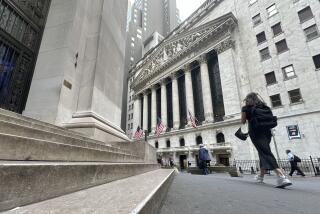Russell Falls Through Bear Market Threshold
NEW YORK — It’s official: There is a bear market in small stocks--the first since 1990.
The Russell 2,000 index of small-company shares fell 3.94 points, or 1%, to 389.76 on Tuesday, leaving it 20.7% below its April 21 record high.
By most definitions, a 20% drop is the threshold of a bear market for a given index.
The broad market also closed lower Tuesday, as a strong morning rally in blue chips gave way to profit-taking in the afternoon. The Dow Jones industrials, up more than 120 points early on, closed with a gain of 36.04 points at 8,602.65.
The ongoing slide in the Russell index now is the worst since 1990, when, amid a recession triggered by the Persian Gulf crisis, the index fell 30.5% from its mid-June peak to a late-October bottom.
In the 1987 market crash, the index plunged 39% over two months.
Smaller stocks have suffered far worse in the latest market pullback than blue-chip shares. The Standard & Poor’s 500-stock index and the Dow average, both dominated by large stocks, are less than 8% below their July peaks and are still showing healthy gains year to date--12.6% for the S&P; and 8.8% for the Dow.
The Russell, meanwhile, is down 10.8% from where it started the year.
“I don’t recall the disparity ever being so wide,” said Robert F. Dickey, technical analyst at brokerage Dain Rauscher Wessels in Minneapolis.
Analysts say the reasons for smaller stocks’ under-performance boil down to liquidity and investors’ perception of safety.
As uncertainty has mounted over global troubles, major institutional investors such as pension funds have shunned the small-stock group in favor of large, highly liquid issues.
Alert to the preferences of their big customers, Merrill Lynch, Salomon Smith Barney and other leading brokerages have pared down the list of smaller stocks in which they make a market or act as buyer or seller of last resort. The departure of such big market makers has only worsened the liquidity problems.
While many smaller stocks now appear to be far cheaper than the blue chips in terms of their price-to-earnings ratios, “the institutions’ liquidity needs take precedence over their concerns about P/E ratios,” said Rao Chalasani, strategist for Everen Securities in Chicago.
Things will get even worse for smaller stocks if investors start to believe that the U.S. economy is headed for recession, or that the blue chips are falling into a bear market of their own, he added.
But more optimistic observers say investors can’t overlook the bargains forever.
“On a relative basis, looking at P/Es, this is the most attractively positioned small-cap market we’ve had in 25 years,” said J.C. Cabrera, head of small-cap growth funds for State Street Research in Boston.
The current values are as good as they were in 1974, when small stocks began a 10-year run of outperformance, Cabrera said.
But timing a turnaround is always the hard part. Even those who believe the small stocks have hit bottom concede that they could stumble along for a much longer period without making significant gains.
And there is always potential for disaster in individual stocks. Unexpectedly poor earnings announcements are being met with one-day drops of 30% or more--much worse punishment than is usually meted out for large-cap stocks bearing bad news.
Cabrera does not advocate dumping blue chips for smaller stocks across the board, but recommends that investors who don’t have smaller stocks in their portfolios should start mixing them in.
John Ballen, manager of the MFS Emerging Growth Fund in Boston, offered three signals for spotting a bottom in small-cap stocks: Companies repurchase their shares more aggressively, insider buying by executives starts rising, and takeover activity increases.
Ballen said that three companies in his portfolio have announced significant buyback plans in recent days, but that the other two signals have yet to start flashing.
According to research by Dain Rauscher’s Dickey, the Russell 2,000’s performance relative to the S&P; 500 has lately been running in precise nine-month cycles.
Since 1994, there have been six cycles in which the Russell has swung from under-performance to outperformance. Each time, the under-performance low point has been almost exactly nine months after the previous one.
By those calculations, the Russell is due for an upswing--relative to the S&P; 500, at least--beginning next month.
But Dickey acknowledged with a laugh that researchers often discover such remarkable cycles exactly at the point when they break down.
*
Market Roundup, D9
(BEGIN TEXT OF INFOBOX / INFOGRAPHIC)
Mauled by the Bear
The Russell 2,000 index of smaller stocks has now fallen more than 20% from its April peak, which means a bear market in those stocks is underway--the first since 1990. Monthly closes and latest:
Tuesday: 389.76
Source: Bloomberg News
More to Read
Inside the business of entertainment
The Wide Shot brings you news, analysis and insights on everything from streaming wars to production — and what it all means for the future.
You may occasionally receive promotional content from the Los Angeles Times.









